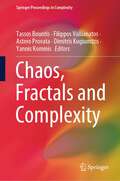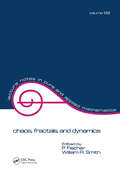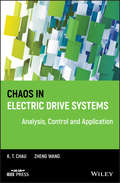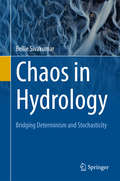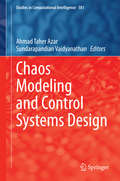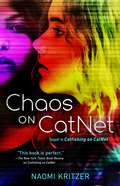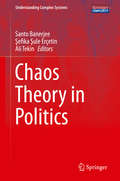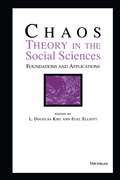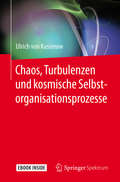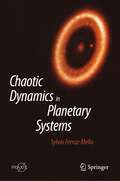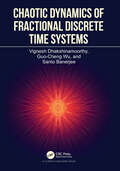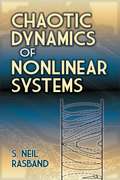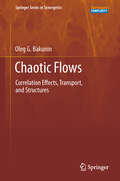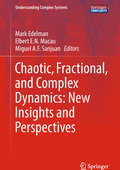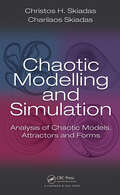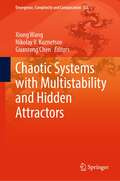- Table View
- List View
Chaos, dynamics, and fractals
by Joseph L. MccauleyThis book develops deterministic chaos and fractals from the standpoint of iterated maps, but the emphasis makes it very different from all other books in the field. It provides the reader with an introduction to more recent developments, such as weak universality, multifractals, and shadowing, as well as to older subjects like universal critical exponents, devil's staircases and the Farey tree. The author uses a fully discrete method, a â theoretical computer arithmetic', because finite (but not fixed) precision cannot be avoided in computation or experiment. This leads to a more general formulation in terms of symbolic dynamics and to the idea of weak universality. The connection is made with Turing's ideas of computable numbers and it is explained why the continuum approach leads to predictions that are not necessarily realized in computation or in nature, whereas the discrete approach yields all possible histograms that can be observed or computed.
Chaos, Fractals and Complexity (Springer Proceedings in Complexity)
by Tassos Bountis Filippos Vallianatos Astero Provata Dimitris Kugiumtzis Yannis KominisThis volume of proceedings contains research results within the framework of the fields of Chaos, Fractals and Complexity, written by experienced professors, young researchers, and applied scientists. It includes reviews of the fields, which are presented in an educational way for the widest possible audience, analytical results, computer simulations and experimental evidence, focusing on mathematical modelling. The papers presented here are selected from lectures given at the 28th Summer School “Dynamical Systems and Complexity”, July 18 – 27, 2022. Topics cover applications of complex systems in Neuroscience, Biology, Photonics, Seismology, Meteorology, and more broadly Physical and Engineering systems. The summer school has a long history, which began at the University of Patras in 1987 and continues with great success to this day. The original main purpose was to introduce young students and researchers of Greece to a new science that emerged several decades ago and continues to grow internationally at an ever increasing rate around the world.
Chaos, Fractals, and Dynamics
by P. FischerThis book contains eighteen papers, all more-or-less linked to the theory of dynamical systems together with related studies of chaos and fractals. It shows many fractal configurations that were generated by computer calculations of underlying two-dimensional maps.
Chaos in Dynamical Systems
by Edward OttIn the new edition of this classic textbook Ed Ott has added much new material and has significantly increased the number of homework problems. The most important change is the addition of a completely new chapter on control and synchronization of chaos. Other changes include new material on riddled basins of attraction, phase locking of globally coupled oscillators, fractal aspects of fluid advection by Lagrangian chaotic flows, magnetic dynamos, and strange nonchaotic attractors.
Chaos in Electric Drive Systems: Analysis, Control and Application (Wiley - IEEE)
by K. T. Chau Zheng WangIn Chaos in Electric Drive Systems: Analysis, Control and Application authors Chau and Wang systematically introduce an emerging technology of electrical engineering that bridges abstract chaos theory and practical electric drives. The authors consolidate all important information in this interdisciplinary technology, including the fundamental concepts, mathematical modeling, theoretical analysis, computer simulation, and hardware implementation. The book provides comprehensive coverage of chaos in electric drive systems with three main parts: analysis, control and application. Corresponding drive systems range from the simplest to the latest types: DC, induction, synchronous reluctance, switched reluctance, and permanent magnet brushless drives. The first book to comprehensively treat chaos in electric drive systems Reviews chaos in various electrical engineering technologies and drive systems Presents innovative approaches to stabilize and stimulate chaos in typical drives Discusses practical application of chaos stabilization, chaotic modulation and chaotic motion Authored by well-known scientists in the field Lecture materials available from the book's companion website This book is ideal for researchers and graduate students who specialize in electric drives, mechatronics, and electric machinery, as well as those enrolled in classes covering advanced topics in electric drives and control. Engineers and product designers in industrial electronics, consumer electronics, electric appliances and electric vehicles will also find this book helpful in applying these emerging techniques. Lecture materials for instructors available at www.wiley.com/go/chau_chaos
Chaos in Hydrology: Bridging Determinism and Stochasticity
by Bellie SivakumarThis authoritative book presents a comprehensive account of the essential roles of nonlinear dynamic and chaos theories in understanding, modeling, and forecasting hydrologic systems. This is done through a systematic presentation of: (1) information on the salient characteristics of hydrologic systems and on the existing theories for their modeling; (2) the fundamentals of nonlinear dynamic and chaos theories, methods for chaos identification and prediction, and associated issues; (3) a review of the applications of chaos theory in hydrology; and (4) the scope and potential directions for the future. This book bridges the divide between the deterministic and the stochastic schools in hydrology, and is well suited as a textbook for hydrology courses.
Chaos Modeling and Control Systems Design (Studies in Computational Intelligence #581)
by Ahmad Taher Azar Sundarapandian VaidyanathanThe development of computational intelligence (CI) systems was inspired by observable and imitable aspects of intelligent activity of human being and nature. The essence of the systems based on computational intelligence is to process and interpret data of various nature so that that CI is strictly connected with the increase of available data as well as capabilities of their processing, mutually supportive factors. Developed theories of computational intelligence were quickly applied in many fields of engineering, data analysis, forecasting, biomedicine and others. They are used in images and sounds processing and identifying, signals processing, multidimensional data visualization, steering of objects, analysis of lexicographic data, requesting systems in banking, diagnostic systems, expert systems and many other practical implementations. This book consists of 15 contributed chapters by subject experts who are specialized in the various topics addressed in this book. The special chapters have been brought out in the broad areas of Control Systems, Power Electronics, Computer Science, Information Technology, modeling and engineering applications. Special importance was given to chapters offering practical solutions and novel methods for the recent research problems in the main areas of this book, viz. Control Systems, Modeling, Computer Science, IT and engineering applications. This book will serve as a reference book for graduate students and researchers with a basic knowledge of control theory, computer science and soft-computing techniques. The resulting design procedures are emphasized using Matlab/Simulink software.
Chaos, Noise and Fractals
by E R Pike; L A LugiatoThe study of nonlinear dynamical systems has been gathering momentum since the late 1950s. It now constitutes one of the major research areas of modern theoretical physics. The twin themes of fractals and chaos, which are linked by attracting sets in chaotic systems that are fractal in structure, are currently generating a great deal of excitement. The degree of structure robustness in the presence of stochastic and quantum noise is thus a topic of interest. Chaos, Noise and Fractals discusses the role of fractals in quantum mechanics, the influence of phase noise in chaos and driven optical systems, and the arithmetic of chaos. The book represents a balanced overview of the field and is a worthy addition to the reading lists of researchers and students interested in any of the varied, and sometimes bizarre, aspects of this intriguing subject.
Chaos on CatNet: Sequel to Catfishing on CatNet (A CatNet Novel #2)
by Naomi Kritzer“This book is perfect.”—The New York Times Book Review on Catfishing on CatNetIt takes an AI to catch an AI in Chaos on CatNet, the follow-up to Naomi Kritzer's award-winning near future YA thriller.When a mysterious entity starts hacking into social networks and chat rooms to instigate paranoia and violence in the real world, it’s up to Steph and her new friend, Nell, to find a way to stop it—with the help of their benevolent AI friend, CheshireCat.Praise for Catfishing on CatNetA New York Times Book Review Editors’ Choice/Staff PickA Kirkus Reviews Best BookA Junior Library Guild SelectionAn Edgar Award Winner for Best Young Adult NovelA Minnesota Book Award Winner for Best Young Adult NovelAn Andre Norton Nebula Award FinalistAn ITW Thriller Award for Best YA Novel NomineeA Lodestar Award Winner for Best Young Adult Book Midwest Connections Pick (Midwest Independent Booksellers Association) “A first-rate YA novel.”—Locus Magazine“Positive, realistic LGBTQIA+ representation—especially nonbinary identities. Wickedly funny and thrilling in turns; perfect for readers coming-of-age online.”—Kirkus (starred review)At the Publisher's request, this title is being sold without Digital Rights Management Software (DRM) applied.
Chaos, Synchronization and Structures in Dynamics of Systems with Cylindrical Phase Space (Understanding Complex Systems)
by Nikolai Verichev Stanislav Verichev Vladimir ErofeevThis book develops analytical methods for studying the dynamical chaos, synchronization, and dynamics of structures in various models of coupled rotators. Rotators and their systems are defined in a cylindrical phase space, and, unlike oscillators, which are defined in Rn, they have a wider “range” of motion: There are vibrational and rotational types for cyclic variables, as well as their combinations (rotational-vibrational) if the number of cyclic variables is more than one. The specificity of rotator phase space poses serious challenges in terms of selecting methods for studying the dynamics of related systems. The book chiefly focuses on developing a modified form of the method of averaging, which can be used to study the dynamics of rotators. In general, the book uses the “language” of the qualitative theory of differential equations, point mappings, and the theory of bifurcations, which helps authors to obtain new results on dynamical chaos in systems with few degrees of freedom. In addition, a special section is devoted to the study and classification of dynamic structures that can occur in systems with a large number of interconnected objects, i.e. in lattices of rotators and/or oscillators. Given its scope and format, the book can be used both in lectures and courses on nonlinear dynamics, and in specialized courses on the development and operation of relevant systems that can be represented by a large number of various practical systems: interconnected grids of various mechanical systems, various types of networks including not only mechanical but also biological systems, etc.
Chaos Theory (Bullet guides)
by Ron Poet David PoetOpen this book and you will <P><P>Discover the origins of chaos theory <P>Investigate complex systems<P>Understand the causes of chaos<P> Become aware of its everyday implications
Chaos Theory: Bullet Guides
by Dr Ron PoetOpen this book and you will Discover the origins of chaos theory Investigate complex systems Understand the causes of chaos Become aware of its everyday implications
Chaos Theory in Politics (Understanding Complex Systems)
by Santo Banerjee Şefika Şule Erçetin Ali TekinThe present work investigates global politics and political implications of social science and management with the aid of the latest complexity and chaos theories. Until now, deterministic chaos and nonlinear analysis have not been a focal point in this area of research. This book remedies this deficiency by utilizing these methods in the analysis of the subject matter. The authors provide the reader a detailed analysis on politics and its associated applications with the help of chaos theory, in a single edited volume.
Chaos Theory in the Social Sciences
by L. Douglas Kiel Euel ElliottChaos Theory in the Social Sciences: Foundations and Applicationsoffers the most recent thinking in applying the chaos paradigm to the social sciences. The book explores the methodological techniques--and their difficulties--for determining whether chaotic processes may in fact exist in a particular instance and examines implications of chaos theory when applied specifically to political science, economics, and sociology. The contributors to the book show that no single technique can be used to diagnose and describe all chaotic processes and identify the strengths and limitations of a variety of approaches. The essays in this volume consider the application of chaos theory to such diverse phenomena as public opinion, the behavior of states in the international arena, the development of rational economic expectations, and long waves. Contributors include Brian J. L. Berry, Thad Brown, Kenyon B. DeGreene, Dimitrios Dendrinos, Euel Elliott, David Harvey, L. Ted Jaditz, Douglas Kiel, Heja Kim, Michael McBurnett, Michael Reed, Diana Richards, J. Barkley Rosser, Jr. , and Alvin M. Saperstein. L. Douglas Kiel and Euel W. Elliott are both Associate Professors of Government, Politics, and Political Economy, University of Texas at Dallas.
Chaos, Turbulenzen und kosmische Selbstorganisationsprozesse
by Ulrich Von KusserowDieses Buch bietet eine anschauliche und reich bebilderte Übersicht zur Vielfalt kosmischer Turbulenz- und Selbstorganisationsszenarien und ermöglicht umfassende Einblicke in die dabei in ganz unterschiedlichen Zusammenhängen ablaufenden Vorgänge und zugrundeliegenden theoretischen Konzepte. Es richtet sich an fachwissenschaftlich interessierte Laien, Studenten und Wissenschaftler, die einen Einstieg in diese Themenbereiche suchen. Der Autor zeigt auf, nach welchen Gesetzen Selbstorganisationsprozesse überall im Kosmos insbesondere auch die Entstehung der Galaxien, Sterne und Planeten sowie die Entwicklung des Lebens auf dem Planeten Erde möglich gemacht haben. In ansprechender Weise schlägt er einen weiten Bogen über eine Vielzahl chaotischer Vorgänge und Turbulenzen, geordneter Strukturbildungs- und Entwicklungsprozesse in der Natur, die uns Menschen aus dem Alltagsleben teilweise sehr wohl bekannt sind. Die näheren Erläuterungen mathematisch-physikalischer Modellierungsansätze und wissenschaftlicher Forschungsmethoden ermöglichen dem Leser ein wesentlich grundlegenderes Verständnis der dabei Einfluss nehmenden physikalischen, chemischen und biologischen Prozesse.
Chaotic Dynamics
by Geoffrey R. GoodsonThis undergraduate textbook is a rigorous mathematical introduction to dynamical systems and an accessible guide for students transitioning from calculus to advanced mathematics. It has many student-friendly features, such as graded exercises that range from straightforward to more difficult with hints, and includes concrete applications of real analysis and metric space theory to dynamical problems. Proofs are complete and carefully explained, and there is opportunity to practice manipulating algebraic expressions in an applied context of dynamical problems. After presenting a foundation in one-dimensional dynamical systems, the text introduces students to advanced subjects in the latter chapters, such as topological and symbolic dynamics. It includes two-dimensional dynamics, Sharkovsky's theorem, and the theory of substitutions, and takes special care in covering Newton's method. Mathematica code is available online, so that students can see implementation of many of the dynamical aspects of the text.
Chaotic Dynamics in Planetary Systems (Springer Praxis Books)
by Sylvio Ferraz-MelloThe main theme of the book is the presentation of techniques used to identify chaotic behavior in the evolution of conservative mechanical systems and their application to astronomical systems. It results from graduate courses given by the author over the years both at university and at several international summer schools.Along the book surfaces of section, Lyapunov characteristic exponents, frequency maps, MEGNO, dense grid maps, etc., are presented and discussed in connection with the applications. The initial chapter is devoted to the presentation of the main ideas of the chaotic dynamics of conservative systems in plain language so that they can be accessible to a wide range of professionals and students of physical sciences. The applications are mainly related to the motions in the solar system and extrasolar planetary systems.Another chapter is devoted to the applications to asteroids showing how the asteroidal belt is sculpted by chaos and resonances. The contrasting existence of gaps in the distribution of the asteroids and groups of asteroids in resonances is thoroughly discussed. The interest in applications to planetary systems is growing since the discovery of systems of resonant planets around some stars of the solar neighborhood. Exoplanets added a lot of cases to a problem that was before restricted to the planets of our solar system. The book includes an account of results already existing about compact systems.
Chaotic Dynamics of Fractional Discrete Time Systems
by Santo Banerjee Vignesh Dhakshinamoorthy Guo-Cheng WuThe book reviews the application of discrete fractional operators in diverse fields such as biological and chemical reactions, as well as chaotic systems, demonstrating their applications in physics. The dynamical analysis is carried out using equilibrium points of the system for studying their stability properties and the chaotic behaviors are illustrated with the help of bifurcation diagrams and Lyapunov exponents.The book is divided into three parts. Part I deals with the application of discrete fractional operators in chemical reaction-based systems with biological significance. Two different chemical reaction models are analysed- one being disproportionation of glucose, which plays an important role in human physiology and the other is the Lengyel – Epstein chemical model. Chaotic behavior of the systems is studied and the synchronization of the system is performed. Part II covers the analysis of biological systems like tumor immune system and neuronal models by introducing memristor based flux control. The memductance functions are considered as quadratic, periodic, and exponential functions. The final part of the book reviews the complex form of the Rabinovich-Fabrikant system which describes physical systems with strong nonlinearity exhibiting unusual behavior.
Chaotic Dynamics of Nonlinear Systems (Dover Books on Physics)
by S. Neil RasbandWritten when the young science of chaos was gaining a foothold in the scientific community, this book introduces the field's concepts, applications, theory, and technique. Suitable for advanced undergraduates and graduate students, researchers, and teachers of mathematics, physics, and engineering, the text's major prerequisite is familiarity with differential equations and linear vector spaces. Author S. Neil Rasband discusses the major models for the transitions to chaos exhibited by dynamic systems, introducing the "classical" topics and examples fundamental to the discipline. The most important routes to chaos are presented within a unified framework and supported by integrated problem sets. Topics include one- and two-dimensional maps, universality theory, fractal dimension, differential and conservative dynamics, and other subjects. The text is supplemented by a helpful glossary, references, and an index.
Chaotic Flows: Correlation Effects, Transport, and Structures (Springer Series in Synergetics #10)
by Oleg G. BakuninThe book introduces readers to and summarizes the current ideas and theories about the basic mechanisms for transport in chaotic flows. Typically no single paradigmatic approach exists as this topic is relevant for fields as diverse as plasma physics, geophysical flows and various branches of engineering. Accordingly, the dispersion of matter in chaotic or turbulent flows is analyzed from different perspectives. Partly based on lecture courses given by the author, this book addresses both graduate students and researchers in search of a high-level but approachable and broad introduction to the topic.
Chaotic, Fractional, and Complex Dynamics: New Insights and Perspectives (Understanding Complex Systems)
by Miguel A. F. Sanjuan Mark Edelman Elbert E. N. MacauThe book presents nonlinear, chaotic and fractional dynamics, complex systems and networks, together with cutting-edge research on related topics. The fifteen chapters - written by leading scientists working in the areas of nonlinear, chaotic, and fractional dynamics, as well as complex systems and networks - offer an extensive overview of cutting-edge research on a range of topics, including fundamental and applied research. These include but are not limited to, aspects of synchronization in complex dynamical systems, universality features in systems with specific fractional dynamics, and chaotic scattering. As such, the book provides an excellent and timely snapshot of the current state of research, blending the insights and experiences of many prominent researchers.
Chaotic Harmony: A Dialog about Physics, Complexity and Life (Emergence, Complexity and Computation #11)
by Ali Sanayei Otto E. RösslerThis fascinating book written by Ali Sanayei and Otto E. Rössler is not a classic scientific publication, but a vivid dialogue on science, philosophy and the interdisciplinary intersections of science and technology with biographic elements. Chaotic Harmony: A Dialog about Physics, Complexity and Life represents a discussion between Otto Rössler and his colleague and student, focusing on the different areas of science and highlights their mutual relations. The book's concept of interdisciplinary dialogue is unusual nowadays although it has a long tradition in science. It provides insight not only into interesting topics that are often closely linked, but also into the mind of a prominent scientist in the field of physics, chaos and complexity in general. It allows a deep look into the fascinating process of scientific development and discovery and provides a very interesting background of known and unknown facts in the areas of complex processes in physics, cosmology, biology, brains and systems in general. This book will be valuable to all who are interested in science, its evolution and in an unconventional and original look at various issues. Surely it can serve as an inspiration for students, explaining the often overlooked fact that science and philosophy enrich each other.
Chaotic Modelling and Simulation: Analysis of Chaotic Models, Attractors and Forms
by Christos H. Skiadas Charilaos SkiadasOffers Both Standard and Novel Approaches for the Modeling of SystemsExamines the Interesting Behavior of Particular Classes of ModelsChaotic Modelling and Simulation: Analysis of Chaotic Models, Attractors and Forms presents the main models developed by pioneers of chaos theory, along with new extensions and variations of these models. Using more
The Chaotic Solar Cycle (Atmosphere, Earth, Ocean & Space)
by Arnold HanslmeierThis book offers an overview of solar physics with a focus on solar activity, particularly the activity cycle. It is known that solar activity varies periodically, but there are also phases of intermittency, such as the Maunder minimum, during which solar activity is very low or high over several decades. The book provides a brief introduction to chaos theory and investigates solar activity in terms of its chaotic behavior. It also discusses how intermittent phases of solar activity have affected and can affect Earth’s climate and long-term space weather, and reviews the underlying theories relating to the solar dynamo mechanism. Furthermore, each chapter includes references to scientific literature (review articles and papers) so that readers can delve deeper into the subjects covered. This richly illustrated book will appeal to a wide readership, and is also useful as a textbook for courses in solar physics and astrophysics.
Chaotic Systems with Multistability and Hidden Attractors (Emergence, Complexity and Computation #40)
by Xiong Wang Nikolay V. Kuznetsov Guanrong ChenThis book presents a collection of new articles written by world-leading experts and active researchers to present their recent finding and progress in the new area of chaotic systems and dynamics, regarding emerging subjects of unconventional chaotic systems and their complex dynamics.It guide readers directly to the research front of the new scientific studies. This book is unique of its kind in the current literature, presenting broad scientific research topics including multistability and hidden attractors in unconventional chaotic systems, such as chaotic systems without equilibria, with only stable equilibria, with a curve or a surface of equilibria. The book describes many novel phenomena observed from chaotic systems, such as non-Shilnikov type chaos, coexistence of different types of attractors, and spontaneous symmetry breaking in chaotic systems. The book presents state-of-the-art scientific research progress in the field with both theoretical advances and potential applications. This book is suitable for all researchers and professionals in the areas of nonlinear dynamics and complex systems, including research professionals, physicists, applied mathematicians, computer scientists and, in particular, graduate students in related fields.

